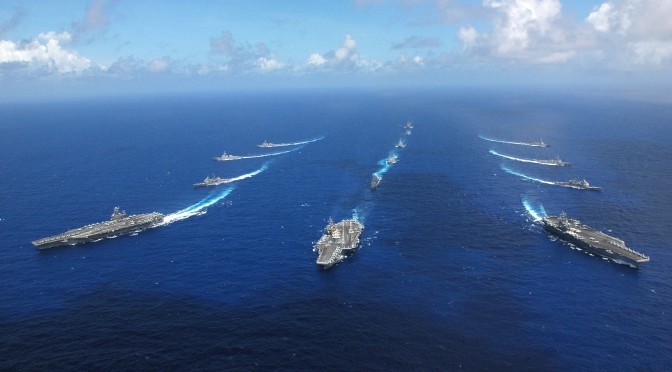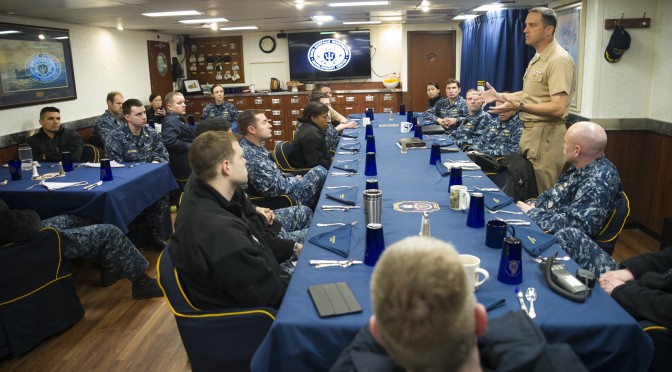By Dmitry Filipoff
Introduction
“One must be ready to change his line sharply and suddenly, with no concern for the prejudices and memories of what was yesterday. To rest upon formula is a slumber that, prolonged, means death.”-Admiral Hyman G. Rickover.1
Distributed lethality is a concept that was officially launched a year ago by Navy leadership to explore how dispersing forces would enhance warfighting. Traditionally, dispersion has been a cardinal sin in the highly decisive nature of naval warfare, but new threats and capabilities may have changed this principle that has long guided the employment of warships. This analysis aims to show how distributed lethality can offer versatile means for achieving political and military objectives in an era of lean budgets and evolving threats.
Warfighting Characteristics
“More ships with more firepower acting more independently will increase the planning complexity and resourcing of our potential challengers.”-Vice Adm. Tom Rowden, Commander U.S. Naval Surface Forces.2
Navy leaders assert that distributed lethality will “add battlespace complexity”3 and “complicate the calculus” of an adversary. How will dispersed surface action groups (SAG) accomplish this compared to traditional carrier strike groups (CSG), and how will dispersion affect operations in the electromagnetic (EM) domain?
Distributed lethality attacks left on the kill chain, meaning it intends to influence the earlier phases of the process by which targets are located, identified, targeted, engaged, and effects are assessed. Aside from increasing search volume, dispersion challenges intelligence, surveillance, and reconnaissance (ISR) through modularity. In a CSG centric navy, the detection of a large surface combatant increases the probability of learning the disposition of other warships, including valuable capital ships, and of knowing the operational unit they are arrayed in. The modularity offered by dispersed SAGs exacerbates the ISR challenge by reducing the certainty of what kinds of forces may be acting in concert with a potential contact, and what their capabilities and missions are. This will complicate prioritization of ISR and firepower, and increase the probability of expending precision guided munitions (PGM) due to forced error.4
However, distributed lethality will induce friction on the dispersed force. It is presumed that naval forces will employ emissions control (EMCON) techniques to frustrate the adversary in the EM domain. But EMCON exacerbates the challenges inherent to coordinating a dispersed force. Prior Navy experimentation discovered these challenges. Operations Haystack and Uptide revealed that dispersed operations under EMCON dramatically increase carrier survivability against submarines and land based bombers but at the expense of lengthened decision cycles.5 Under electromagnetic opposition, the degradation of confidence in the networking of a distributed force is easier because of additional variables to be accounted for and that can be influenced by enemy action. Aggregated forces can also more easily employ alternative means of communication compared to distributed forces.
Lengthened decision cycles for dispersed forces causes handicaps and presents dilemmas. Operations whose success is contingent upon careful coordination are less likely to succeed. The ability to mass capability on short notice amidst determined opposition is impaired. Planners must consider the extent that a SAG may be tied down by enemy action and its own tasking, and the resulting impact on total force flexibility. Operations must have built in flexibility and consider myriad contingencies. Scenarios where SAGs may be called upon to support one another will pose a challenge given how the Navy’s offensive firepower may soon outstick its defensive firepower. These realities will place a premium on inclusive planning and the Navy’s command by negation tradition.
Dispersion will complicate the enemy’s ISR at the expense of reducing one’s own C2 agility. It is important to note that C2 is not just further left in the kill chain than ISR and targeting, but threads the entire process together. These realities may make distributed lethality inflexible under certain circumstances, and result in a higher echelon commander’s intent being articulated in broader terms and with more modest aims. Vice Adm. Ted N. Branch, Deputy Chief of Naval Operations for Information Dominance, pointedly reminded that “the assured C2 pillar touches almost everything we do.”6 The nature of modern conventional warfare has made the EM domain the battleground for superior decision making, and distributed lethality affects the kill chain of all parties.
Distributed Lethality versus Anti-Access/Area Denial
“As they seek greater influence, we confront states that seek to compromise freedom of the seas, where conflict and coercion are increasingly common.“–Chief of Naval Operations Adm. John. M Richardson.7
The Anti-Access/Area Denial (A2/AD) environment is the threat environment dominating the thinking of senior Navy leaders. What advantages does distributed lethality offer in meeting the A2/AD challenge?
Combating an A2/AD adversary could involve operations spanning multiple areas including blue water sea control, power projection into the littoral and across land. While the CSG is a formidable asset against the warships of a near peer adversary, a salvo competition between a CSG and A2/AD forces, especially land based forces, would be suicidal. The A2/AD model is attrition based. Its predominant advantage over expeditionary forces is the logistical sustainment of PGM, ensuring victory in a salvo competition if accurate targeting is sustained. By denying commons, A2/AD reduces freedom of maneuver and raises the probability of attrition based operations, forcing expeditionary forces into the A2/AD’s strength.
Distributed lethality counters A2/AD’s attrition model through maneuver warfare’s intent to probe for weakness and influence psychology. Dispersion facilitates multiple points of entry into theater, allowing for more sea control and maneuver. This in turn strains the anti-access mission and forces the adversary into executing area denial simultaneously. Distributed forces can probe more areas of the A2/AD envelope to gain intelligence on the opponent’s ISR capabilities and discover the true extent of their maritime domain awareness (MDA), setting the stage for follow on operations. Complicating ISR and targeting offsets logistical superiority by injecting uncertainty.
Platforms and Capabilities
“The Navy must be able to access any domain – and possess the mix of kinetic and non-kinetic weapons necessary to prevail today and tomorrow.”-Rear Adm. Mathias W. Winter, Chief of Naval Research.8
Distributed lethality will benefit from the numerous capabilities the Navy is developing to maintain its edge. The concept seeks to employ platforms in different ways, and promote versatility to make the most of limited resources. How could the Navy employ its warships differently and which capabilities should be prioritized?
In a 2014 CIMSEC article Admiral Tom Rowden, then director of Surface Warfare Directorate OPNAV N96, articulated a concept of dispersed lethality and asserted a distributed force will not be dependent on the air wing.9 While distributed lethality deemphasizes carrier strike missions, the air wing will be a critical enabler for the distributed force. A distributed air wing can provide rapid response anti-submarine warfare capability and function as communications relays for maintaining a responsive decision cycle while the dispersed force operates under EMCON. The air wing’s screening and early warning functions will be indispensable for enabling commanders on the scene to exercise initiative and engage on their own terms. The air wing will refocus from the right side to the left on the kill chain.
Much has been made of a recent memo issued by Secretary of Defense Ash Carter to Secretary of the Navy Ray Mabus on the Navy’s programs. The most significant directives include cutting procurement of the littoral combat ship (LCS) from 52 hulls to 40, and procuring 31 additional F-35C aircraft.10 It is important to note that distributed lethality was born from a wargame at the Naval War College where a LCS equipped with a long range surface to surface missile “added stress and complexity to the red force commander, who had to spend precious ISR resources trying to find these upgunned ships.”11 If aircraft and fast frigates/LCS are mutually exclusive investments in the near term, the Navy should explore whether it needs more shooters in the form of additional warships or air wing enablers performing the aforementioned missions.

A payload that has been wisely distributed across the Navy’s warships is the AN/SLQ-32 electronic warfare (EW) system. The Block III increment of the Surface Electronic Warfare Improvement Program (SEWIP) will provide common electronic attack capability to surface combatants.12 Not only does the CSG focus large surface combatants on the defensive application of anti-air warfare (AAW), it does the same for EW. A distributed force equipped with an offensive EW capability could cause great disruption to an adversary’s ISR picture, reinforcing distributed lethality’s intent to attack left on the kill chain. As a part of a proposed acquisition fastlane, Chief of Naval Operations Adm. John Richardson has singled out EW capabilities as “candidates for this kind of rapid acquisition, rapid prototyping”13 which will benefit distributed lethality enormously.
Distributed lethality aims to add more firepower to the fleet, potentially even equipping logistics vessels with missiles as a part of the maxim “if it floats, it fights” issued by OPNAV N96 chief Rear Adm. Peter Fanta.14 However, the Navy should reexamine prioritizing anti-surface warfare (ASuW) capability and consider focusing on land attack. While putting modern anti-ship missiles on more surface combatants would reinvigorate the Navy’s ASuW capability, enhanced power projection across land holds greater deterrence value. The Navy’s land attack proficiency is well honed and proven through recent experience. Thankfully the versatility of the tomahawk missile can enhance both mission sets, but presents the technical challenge of installing vertical launch cells on ships that may have little space and weight to spare.
Arguably no set of capabilities stand to enhance distributed lethality more so than Cooperative Engagement Capability (CEC) and Naval Integrated Fire Control-Counter Air (NIFC-CA). These capabilities allow one platform’s sensors to provide a targeting solution to another platform’s weapons. This will multiply the lethality of a distributed force across vast areas of influence by allowing for the massing of payloads but not platforms. Distributed forces will be able to mitigate risk by mixing and matching whatever combination of sensors and shooters best fits an engagement while ensuring survivability.
Strategic Merit
“…it’s primarily about changing our ways and means right now and the operational concepts we use to achieve our objectives…”- Deputy Secretary of Defense Robert O. Work.15
An operational concept’s warfighting advantages are linked to its deterrence value. How does distributed lethality contribute to deterrence, and what options does it provide policymakers confronting crisis?
Distributed lethality enhances deterrence by influencing psychology through more than just kinetic means. It aims to degrade an adversary’s confidence in their weapons rather than through the threat of overwhelming force, a threat that is not as credible against an A2/AD adversary. Dispersion better allows for demonstrations within the EM domain, which may prove a less escalatory form of conveying resolve than deploying a CSG to a hotspot. The enormous creativity allowed by electromagnetic maritime deception allows for a more nuanced and flexible escalatory dynamic. Demonstration options range from temporarily confusing sensors to simulating strikes against strategic forces with impunity as the Navy did in NORPAC 82.16 Not only does threatening the destruction of networks constitute escalation, it attacks the channels by which deception conveys deterrence.17 During crisis, distributed lethality’s modularity allows for more options in terms of what and how many assets are committed to posturing, giving policymakers a more flexible means for adjusting the “temperature.” Distributed lethality not only has more to offer for maneuver in the military sense, but also politically.
As the threat environment evolves, reassessing the CSG’s deterrence value should occur in tandem with reevaluating its warfighting applications. Captain Robert C. Rubel (ret.) makes the excellent point that “If a lucrative target loaded with potent geopolitical symbolism is on scene, with more on the way, it could precipitate a dangerous “window-of-opportunity” mindset in the opposing government.”18 Sending a CSG to a hotspot could “catalyze as deter” and threaten nightmarish devastation or monumental loss of face as carriers are hurriedly withdrawn for the sake of preservation at the outbreak of war. During the initial phases of conflict, failing to deceive ISR through nonkinetic means could quickly escalate into attempting their physical destruction, up to and including strikes on mainland installations, which is more likely if a carrier’s survival is at stake.
Distributing forces will lower a first strike’s potential for success, which is especially important for deterring an adversary employing A2/AD. Jon Solomon points out an adversary’s maritime domain awareness “will never be as accurate and comprehensive at any later point in a conflict as it is during peacetime’s waning moments.”19 A patrolling, dispersed force would provide a more complex targeting picture, and would reveal more indicators and warning of an impending attack across a larger geographical area. These advantages would be realized by having forward deployed forces already operating in a dispersed manner at Phase 0, or otherwise face the uncomfortable process of transitioning into a dispersed force in the midst of crisis or at the onset of conflict.
Final Thoughts
“It will be orange and it may look kind of odd put together and won’t have the nice slick red/gray paint and it won’t be totally tested and it might fail, but we’ve got to get it out there and see what we can do with that.”-Chief of Naval Operations Adm. Jon Greenert.20
There are additional lines of inquiry that must be explored in order to flesh out distributed lethality. For example, what does it entail for amphibious forces? These forces are more likely to face the littoral arena, and their objectives are set upon fixed geography which limits their freedom of maneuver. The history of naval warfare has shown time and time again that key naval engagements precipitated in relation to developments and objectives on land. Scenarios commonly envisioned today such as a Taiwan contingency or a defense of the Strait of Hormuz demand that the Navy examine distributed lethality in a fixed geographical context. The concept will also challenge the ability to wage coalition warfare, as the careful planning and execution demanded by dispersed operations under EMCON will require ample cooperation and true interoperability.
Nonetheless, distributed lethality offers numerous benefits. It will make the most of what the Navy has today, while maximizing the value of investments that will achieve fruition both in the short and long term. It provides means for confronting the A2/AD challenge, and fulfills Air-Sea Battle’s intent to ensure U.S. forces can “assure access, maintain freedom of action, conduct a show of force, or conduct limited strikes.”21 Ultimately, it provides political and military leadership more flexibility to maneuver within crisis and conflict. The Navy must call upon its rich history of innovation and experimentation to turn distributed lethality into a credible warfighting construct that will deter foes, reassure allies, and make the greatest Navy the world has yet seen greater still.
Dmitry Filipoff is CIMSEC’s Director of Online Content. He can be contacted at Nextwar@cimsec.org.
[1] Admiral Hyman G. Rickover. US Naval Postgraduate School address (16 March 1954).
[2] Vice Adm. Tom Rowden. “Distributed Lethality: The Beginning of the Beginning,” Navy Live (January 20, 2015).
[3] Vice Adm. Thomas Rowden et. al. “Distributed Lethality,” U.S. Naval Institute Proceedings (January 2015).
[4] Solomon, Jon. “Guided Munitions Inventory Management, Producibility, and their Effects on Strategy (Part 1 of 2),” Information Dissemination (November 3, 2014).
[5] Angevine, Robert G. “Hiding in Plain Sight: The U.S. Navy and Dispersed Operations Under EMCON, 1956-1972,” Naval War College Review (Spring 2011).
[6] Vice Adm. Ted N. Branch. “A New Era in Naval Warfare,” U.S. Naval Institute Proceedings (July 2014).
[7] Chief of Naval Operations Adm. John M. Richardson. “The Growing Importance of the Maritime,”10th Regional Seapower Symposium, Venice, Italy (October 22, 2015).
[8] The Fiscal Year 2016 Budget Request United States House of Representatives, 114th Cong. Statement of Rear Admiral Mathias W. Winter, United States Navy Chief of Naval Research. House Armed Services Subcommittee on Emerging Threats and Capabilities (March 26, 2015).
[9] Rear Adm. Thomas S. Rowden. “Surface Warfare: Taking the Offensive,” Center for International Maritime Security (June 14, 2014).
[10] U.S. Navy. “Surface Electronic Warfare Improvement Program (SEWIP),” United States Navy Fact File (November 15, 2013).
[11] Freedberg Jr., Sydney J. “CNO Richardson Urges Fast-Track For Cyber, EW & Drones,” Breaking Defense (December 7, 2015).
[12] Secretary of Defense Ash Carter. “Memorandum for Secretary of the Navy,” United States Department of Defense (December 14, 2015).
[13] Eckstein, Megan. “Navy Studying Implications of Distributed Lethality in Wargames Series,”U.S. Naval Institute News (July 9, 2015).
[14] Freedberg Jr., Sydney J. “ ‘If it Floats, It Fights’: Navy Seeks ‘Distributed Lethality’,” Breaking Defense (January 14, 2015).
[15] Deputy Secretary of Defense Robert O’Work. The Third U.S. Offset Strategy and its Implications for Partners and Allies, Center for a New American Security, Washington D.C. (January 28, 2015).
[16] Pico, Andy. “How to Hide a Task Force,” Navweaps ( June 2, 1999).
[17] Solomon, Jonathan F. “Maritime Deception and Concealment Concepts for Defeating Wide-Area Oceanic Surveillance Reconnaissance-Strike Networks,” Naval War College Review (Autumn 2013).
[18] Capt. Robert C. Rubel (ret.), “Cede No Water: Strategy, Littorals, and Flotillas” U.S. Naval Institute Proceedings (September 2013).
[19] Solomon, Jon. “Parrying the 21st Century First Salvo,” Information Dissemination (October 16, 2014).
[20] Chief of Naval Operations Adm. Jonathan Greenert. Speech given at Naval Future Force Science and Technology Expo, (February 4, 2015).
[21] Air-Sea Battle: Service Collaboration to Address Anti-Access and Area Denial Challenges, United States Department of Defense (May 2013).





